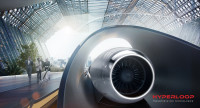Posts by: Margaret Harris
A virtual tour of virtual reality
By Margaret Harris at Photonics West in San Francisco
“How many people in this room are wearing smart glasses today?”
When Bernard Kress, a photonics expert and optical architect on Microsoft’s HoloLens smart-glasses project, posed this question at the Photonics West trade show, he had reason to expect a decent response. He was, after all, speaking at a standing-room-only session on virtual reality, augmented reality and mixed reality (VR, AR and MR), and the audience was packed with tech-friendly, early-adopter types who had come specifically because they’re interested in such devices. Surely, someone in the audience would put up their hand.
View all posts by this author | View this author's profile
Name that column
By Margaret Harris
Covering the commercial side of physics has its challenges. Because physics is such a diverse subject, people who train as physicists find their way into a host of different industries. Once there, they tend to blend in with graduates of other scientific disciplines, who are both more numerous and more likely to have their field in their job title: “physicist” is a relatively uncommon title compared to, say, “engineer”. It also doesn’t help that companies, unlike universities, almost never encourage employees to set up official, publicly accessible websites with contact info and details of what they’re working on right now.
But just because something is difficult doesn’t mean it shouldn’t be done, and one of Physics World’s resolutions for 2018 (right behind laying off the biscuits and getting more exercise) is to put more emphasis on covering industrial and applied physics. As part of that, we’re introducing a new column in the magazine that will explore the interactions between physics, industry and business in general. In this way, we hope to raise the profile of physicists in industry and, by extension, to emphasize the value that physicists bring to the commercial sector.
View all posts by this author | View this author's profile
Reviewing a year in industry
By Margaret Harris
Normally when someone talks about their “year in industry”, they’re referring to a period spent working for a company. My own “year in industry” has been rather different: instead of spending 2017 working in a physics-based industry, I’ve been reporting on half a dozen different ones. From nuclear energy and nanotechnology to optics and instrumentation, I’ve heard from physicists who’ve founded new firms, developed new products and navigated their way through tricky waters with financial backers. Here are a few highlights.
2017 was another high-profile year for physicist and entrepreneur Elon Musk, with his company SpaceX landing a re-used Falcon 9 rocket back in March and his other firm, Tesla Motors, starting to deliver its much-anticipated Model 3 to mere mortals just this week. But in between, there was also a little bit of hype about Musk and hyperloops: vacuum-based systems that could, according to proponents, transport passengers cheaply at more than half the speed of sound. It sounds far-fetched, but as Jon Cartwright revealed in this feature article for August’s Physics World Focus on Vacuum and Instruments, it’s an idea with a long history.
View all posts by this author | View this author's profile
The science and policy of green energy
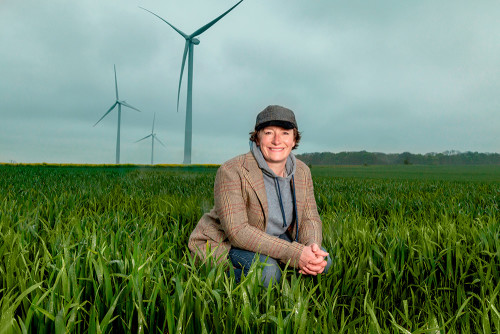
Juliet Davenport at Hampole wind farm near Doncaster. (Courtesy: kalory.co.uk)
By Margaret Harris
In the days following the Great Storm of October 1987, as people across southern England and northern France picked roof tiles and downed tree limbs out of their gardens, Juliet Davenport began thinking seriously about weather.
At the time of the storm, Davenport – now the chief executive of Good Energy, a UK-based supplier and generator of renewable energy – was a third-year physics student at the University of Oxford. She was fascinated to learn that meteorologists (including the BBC’s Michael Fish, who famously told viewers “not to worry” about an approaching hurricane) got their predictions wrong due, in part, to a simple error in the location of ship-based weather observations in the Bay of Biscay, which led them to predict that the storm would follow a more southerly track. “I realized then just how fundamentally sensitive our systems are to data fluctuations,” she told an audience at the University of the West of England (UWE) last night.
Thirty years later, Davenport is still fascinated by the science of weather and climate, but she has also become passionate about the economics of how business becomes an “engine for change” in the world. The role of business in decarbonizing the UK economy was a major theme of her talk. Often, she explained, people regard sustainability and climate change as “someone else’s problem”. That isn’t useful, she said, because “if you expect one part of a society to do all the work, it’s really hard”.
View all posts by this author | View this author's profile
Grabbing a slice of the pie in the sky
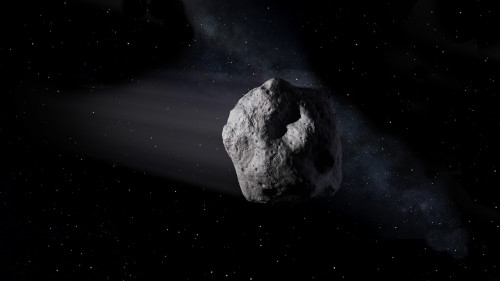
(Courtesy: NASA)
By Margaret Harris at the European Planetary Science Congress in Riga, Latvia
If you wanted to mine an asteroid, what would you need? Right now, it’s a hypothetical question: only a handful of spacecraft have ever visited an asteroid, and fewer still have studied one in detail. As commercial ventures go, it’s not exactly a sure thing. But put that aside for a moment. If you wanted to create an asteroid-mining industry from scratch, how would you do it?
Well, for starters, you’d need to know which asteroids to target. “Not every mountain is a gold mine, and that’s true for asteroids too,” astrophysicist Martin Elvis told audience members at the European Planetary Science Congress (EPSC) yesterday. For every platinum-rich asteroid sending dollar signs into investors’ eyes, Elvis explained there are perhaps 100 commercially useless chunks of carbon whizzing around out there, and the odds for water-rich asteroids aren’t much better. Moreover, some of those valuable asteroids will be impractical to mine, either because of their speed and location or because they’re too small to give a good return on investment. “Smaller asteroids aren’t even worth a billion dollars,” Elvis scoffed. “Who’d get out of bed for that?”
View all posts by this author | View this author's profile
A temporary lack of neutrons
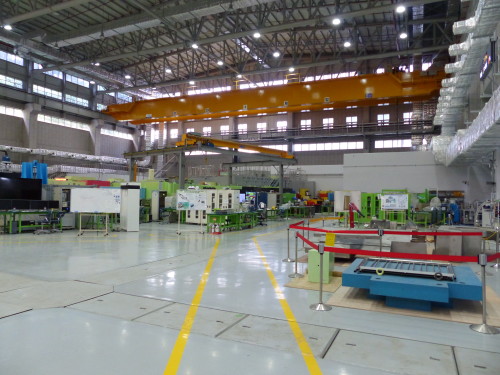
The guide hall at the HANARO research reactor in Daejeon, Republic of Korea.
By Margaret Harris in Daejeon, Republic of Korea
For almost three years, the HANARO research reactor has been idle. Built in 1995 as a hub for neutron-scattering experiments, radioisotope production and other scientific work, HANARO (High Flux Advanced Neutron Application Reactor) is the only facility of its kind in the Republic of Korea, and it underwent a major upgrade in 2009. Then, in 2014, the facility became a delayed casualty of the meltdown at Japan’s Fukushima Dai-Ichi nuclear power station, as enhanced regulatory scrutiny led to the discovery that the reactor hall’s outer wall was not up to the latest standards. An enforced shutdown followed while the wall was reinforced, and although the works were supposed to take just 18 months, opposition from local citizens’ groups has led to further delays.
View all posts by this author | View this author's profile
A spotlight on accelerators in industry – sort of
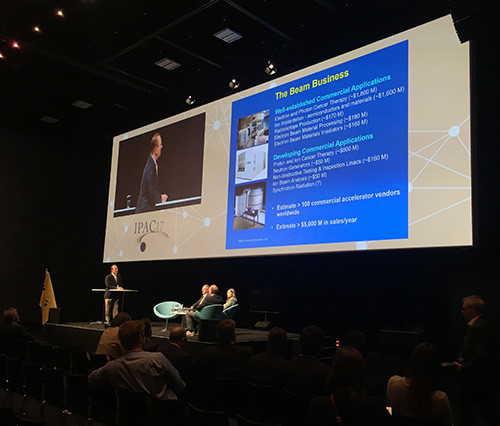
Robert Kephart of Fermilab speaking about the “beam business” at IPAC17.
By Margaret Harris at the International Particle Accelerator Conference in Copenhagen
Normally, you’d expect a particle-accelerator conference to focus on research – either the fundamental research done at accelerator facilities around the world, or the applied research required to get such facilities up and running in the first place. And for the most part, that has been absolutely true of the 8th International Particle Accelerator Conference (IPAC), which is taking place this week on the outskirts of Copenhagen, Denmark.
On Tuesday, however, the conference organizers dedicated a session to the ways that accelerator science engages with industry. In a two-hour series of talks, audience members heard from speakers as varied as Bjerne Clausen, CEO of the Danish chemical technologies firm Haldor Topsoe; Bob Kephart, director of the Fermilab-affiliated Illinois Accelerator Research Center (IARC); and Giovanni Anelli, who leads the Knowledge Transfer group at CERN.
View all posts by this author | View this author's profile
New cosmic messengers, and what they can tell us
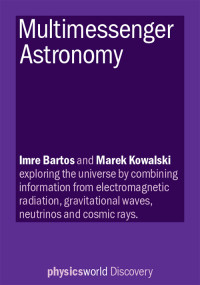 By Margaret Harris
By Margaret Harris
Immediately after last year’s announcement that the Laser Interferometer Gravitational-Wave Observatory (LIGO) had seen its first gravitational waves, a lot of the discussion centred on what the discovery meant for general relativity. This was understandable: getting further confirmation of Einstein’s century-old theory was (and is) a big deal. But in the longer term, and as the LIGO detectors notch up a few more observations (they’re currently crunching data on six new candidates), the emphasis will shift away from the waves themselves, and towards what they can tell us about the universe.
The key thing to realize here is that gravitational waves are fundamentally different from other, better-studied cosmic “messengers” that travel to Earth from distant reaches of the universe. Unlike photons, gravitational waves are not impeded by clouds of gas or dust; unlike cosmic rays, they are not deflected by electromagnetic fields. In addition, some of the most dramatic astrophysical events, such as the merger of two black holes in empty space, are “dark” or “silent” to other messengers: these events produce gravitational waves in copious quantities, but not, as far as we know, anything else.
View all posts by this author | View this author's profile
Following the ups and downs of nuclear energy
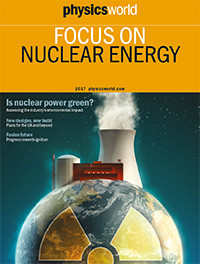 By Margaret Harris
By Margaret Harris
If you’re finding the pace of geopolitical news a bit too rapid at the moment, spare a thought for physicists and engineers working in the nuclear energy sector.
Towards the end of last month, the venerable energy firm Westinghouse Electric issued a press release in which it proudly announced that its AP1000 reactor – a relatively new “passively safe” design in which the reactor core is kept cool without the need for powered pumps or other “active” equipment – had passed a major UK regulatory review. Ordinarily, this would be cause for celebration. The so-called “Generic Design Assessment” process takes years, and completing it helps pave the way for building AP1000s within the UK. An international partnership called NuGen has long hoped to do just that, on a site near Sellafield in north-west England, so in normal times, you might expect it to be celebrating, too.
Your future with physics
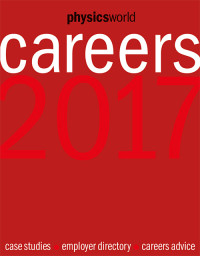 By Margaret Harris
By Margaret Harris
In a typical month, the careers section of Physics World features the stories of two different physicists: one who is working in a physics-related field (such as engineering or teaching), and another who decided to do something totally different (such as designing sailboats or running a winery).
I find these stories endlessly fascinating, and when I was Physics World’s careers editor, I loved sharing them with the wider physics community. But the section isn’t there just to add human interest. It’s also giving current students (and later-career physicists seeking a change) a better idea of what they could do with their physics knowledge in the workplace.
After talking to students and careers professionals, I realized that publishing two stories in the magazine once a month wasn’t really the ideal way of doing this – at least, not for readers who are actively looking for careers ideas, and who might therefore prefer to learn about lots of different options at once.
So with these readers in mind, we’ve come up with a brand-new publication for 2017. The first edition of Physics World Careers contains a selection of the best articles published in the magazine’s careers section last year, plus an extensive employer directory.
View all posts by this author | View this author's profile
